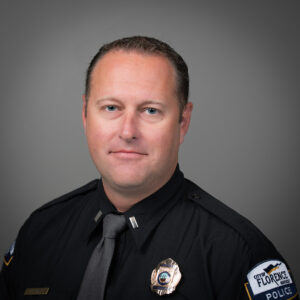Patrol Division

Patrol Division
The Patrol Division is the largest and most visible section of the Florence Police Department. The division provides around the clock coverage to our residents, visitors and businesses. Captain Greg Rehkamp is the Patrol Division Commander. The 50 officers assigned to the division are divided into three shifts, which are ten hours each in duration. Each shift has a lieutenant as the command officer with two sergeants and two corporals as shift supervisors. The shifts are configured to maximize available personnel during peak periods of activity. The patrol division is tasked with providing the initial response to calls for service and the visible presence of the police. Those initial calls for service include a myriad of areas, from providing information, to documenting motor vehicle crashes, to investigating criminal acts. Officers assigned to patrol are required to handle a wide variety of calls, frequently on very short notice. Along with their patrol duties, many of the officers have other specialized assignments that require additional skills and training. The Patrol Division is also comprised of the SWAT Team, the Traffic Unit, the Accident Reconstruction Unit, the Canine Unit, the Training Unit and the Honor Guard.

SWAT Team
The Florence Police Department formed its SWAT (Special Weapons and Tactics) team in 1998. The team has 12 officers assigned as SWAT operators and four officers assigned as negotiators. The team is called to handle high risk or unusual occurrences, such as armed or barricaded persons, search warrants and wanted persons where there is a significant threat to the safety of the public. The officers assigned to the team are required to train frequently to maintain proficiency with current tactics and weapons. The goal of the team is to successfully resolve the situation with the least amount of force necessary. The team is commanded by Lieutenant Roger Allen with Sergeant Erik Daniels as the SWAT team leader and Captain Nathan Rettig as the negotiations supervisor.

Traffic Unit
The traffic unit was established to provide a comprehensive response to traffic concerns in the City. Lieutenant Mike Geis is the unit commander. Officers assigned to this unit are responsible for traffic enforcement and collision investigation. By reviewing traffic collision statistics and complaints, the unit is able to effectively utilize resources to reduce collisions. The department actively seeks grants to provide additional traffic patrols to focus on impaired motorists, careless driving and seat belt enforcement. The goal again is to reduce the number of collisions and associated injuries.
Accident Reconstruction Team
The Accident Reconstruction Unit, under the command of Lieutenant Michael Gonterman, is comprised of highly trained officers who investigate fatal, potentially fatal, and serious traffic collisions. The officers are trained in the technical examination of crashes along with documentation, including photography. Through this training, the officers are able to reconstruct a crash in an effort to determine causation. That determination could potentially result in criminal charges or become a significant piece of civil litigation. The results of these investigations are often used to help traffic engineers in the area of highway safety. In many cases, these investigations provide family members with much needed information as to the tragic circumstances encountered by a loved one.

Canine Unit
The Florence Police Department has a long history of providing exceptional police canine services. The unit is supervised by Lieutenant Roger Allen and consists of four officers (handlers) and their canine partners. The officer/canine team is a full time assignment. The dog spends his working hours and his off duty hours with the officer. The canines are cross-trained to handle patrol duties, such as building searches and tracks, and also drug detection. The teams receive extensive training in both areas. The teams are often requested to provide assistance to other law enforcement agencies. The dog is also well received when conducting demonstrations for groups, especially school children.

Training Unit
The value of training in law enforcement is immeasurable. So many facets of what a police officer does require the most up to date training through a comprehensive program. Along with basic and advanced training that officers are required to receive through the Kentucky Department of Criminal Justice Training (the Academy), officers receive many hours of training in other areas. Those areas include firearms, vehicle operations, defensive tactics, first aid, CPR, evidence collection, legal updates, taser, leadership, management and various other topics. The Florence Police Department has officers trained in most of these areas to provide the necessary instruction. When necessary, the department seeks training from outside qualified individuals. A major component of our training program is our training facility in Grant County. This nine-acre site houses a firing range, a range house and a simunition house available for other training. The facility also has an obstacle course for SWAT training. Upon completing the 20-week basic training academy, new officers return to the department for the field training program, which is commanded by Lieutenant Jason Reed. The officer is paired with a field training officer who monitors progress throughout the 17-week program. The officer receives advanced, individualized training in order to be able to perform his or her required duties. The field training officer is a key component of the program, providing the needed training for new officers.

Honor Guard
The department is proud of the service that our Honor Guard provides. Under the command of Lieutenant Mike Geis, the unit is called upon to perform in a variety of circumstances. The primary purpose of the Honor Guard is to honor a fallen police officer. Our unit has been a part of law enforcement memorial services throughout the region. The officers in the unit also serve during Memorial and Veteran’s Day ceremonies, presentations of colors, parades, 21 gun salutes and other tributes. Many hours are spent training for the precision required to perform those duties.